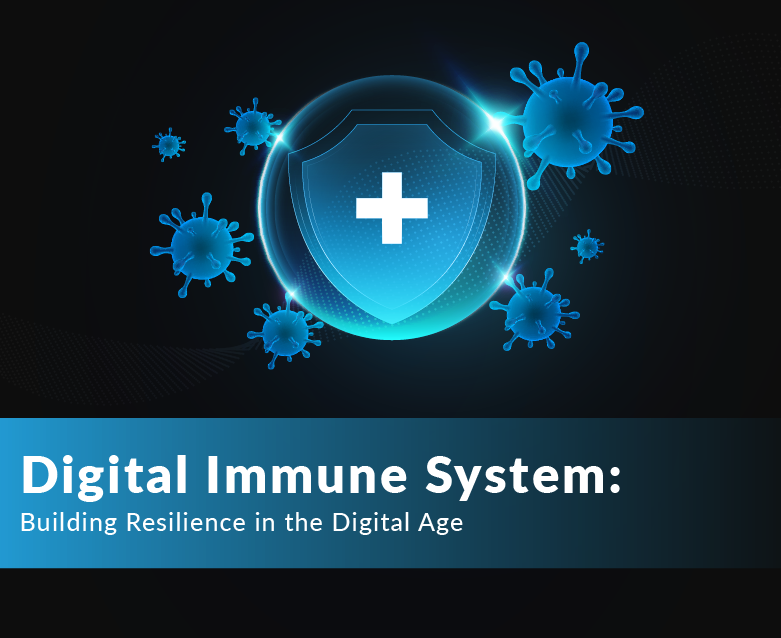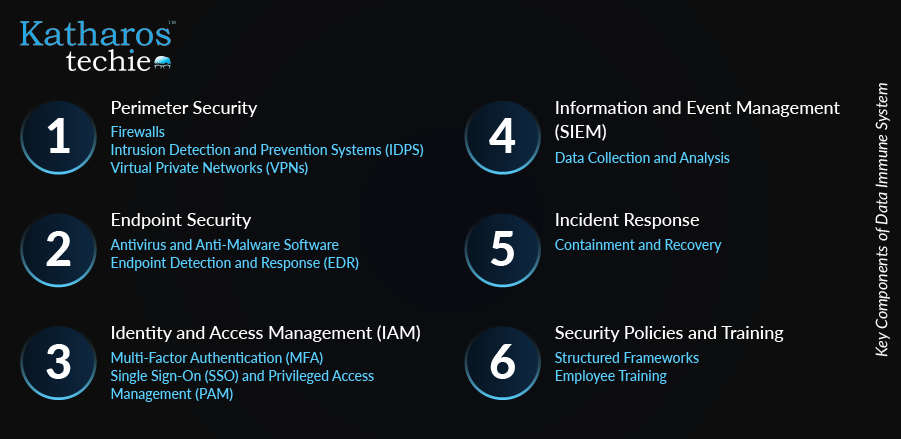
Digital Immune System: Building Resilience in the Digital Age
By Ankita Das

Digital systems are the backbone of modern business and personal life. However, this reliance on technology has also exposed us to numerous cyber threats. These threats can compromise sensitive data, disrupt operations, and damage reputations. As cyber-attacks become more sophisticated, traditional security measures often fall short, highlighting the need for a digital immune system that provides robust and adaptive defense strategies.
Inspired by the human body’s immune system, the Digital Immune System (DIS) concept has emerged as a promising solution. A Digital Immune System mimics the biological immune system’s ability to detect, respond to, and adapt to threats by integrating various cybersecurity tools and technologies. This approach strengthens digital security while improving resilience against future threats. In this blog, we will discuss the intricacies of a Digital Immune System, exploring its key components, benefits, and challenges. Scroll down to learn how you can implement such a system effectively.
What is a Digital Immune System and How Does It Work?
A Digital Immune System (DIS) is a cybersecurity framework that integrates various technologies, processes, and practices to protect digital assets from cyber threats. Inspired by the human immune system, DIS enhances the resilience of digital systems by detecting and adapting to cyber threats. Its primary objective is safeguarding digital operations, ensuring they remain secure, efficient, and resilient against evolving threats. Doing so, helps organizations maintain a robust defense mechanism, reduce the risk of cyber attacks, and ensure a seamless user experience.
The technology combines advanced technologies and processes to create a robust defense mechanism. It continuously monitors digital systems for potential threats, using tools like firewalls and intrusion detection systems to identify and block malicious activity. Once a threat is detected, the system responds by isolating affected areas and initiating remediation. This proactive approach enables organizations to minimize the impact of cyber attacks and ensure quick recovery from security incidents.
Additionally, a Digital Immune System continuously updates its defenses based on new threat intelligence and lessons learned from past incidents, ensuring it remains effective against emerging threats. This adaptability is crucial in today’s rapidly evolving cyber landscape, where new threats emerge daily.
What are the Key Components of a Digital Immune System?

A Digital Immune System comprises several key components that provide robust cybersecurity. These components can be categorized into different layers of defense, each playing a crucial role in protecting digital assets from cyber threats.
1. Perimeter Security
- Firewalls: Firewalls serve as the first line of defense, regulating network traffic according to predefined security rules. They block unauthorized access and malicious data packets.
- Intrusion Detection and Prevention Systems (IDPS): These systems monitor network traffic for signs of unauthorized access or malicious activity, identifying and blocking potential threats.
- Virtual Private Networks (VPNs): VPNs encrypt internet traffic to protect data transmitted over public networks, ensuring confidentiality and integrity.
2. Endpoint Security
- Antivirus and Anti-Malware Software: These tools scan and remove harmful software from individual devices, protecting against viruses, worms, and spyware.
- Endpoint Detection and Response (EDR): EDR solutions monitor endpoint activity to detect and respond to advanced threats that evade traditional antivirus software.
3. Identity and Access Management (IAM)
- Multi-Factor Authentication (MFA): MFA requires users to provide multiple authentication methods to access systems or networks. This approach helps strengthen security by making unauthorized access more difficult.
- Single Sign-On (SSO) and Privileged Access Management (PAM): Single Sign-On (SSO) and Privileged Access Management (PAM) streamline access and maintain security by restricting users to only necessary resources.
4. Information and Event Management (SIEM)
SIEM systems collect and analyze security-related data from multiple sources, such as network devices and servers to identify potential threats. By correlating this data, SIEM systems enable organizations to detect anomalies, and generate alerts. It automates security incident responses, improving threat detection and compliance management.
5. Incident Response
This involves processes and procedures for responding to security incidents. It includes containment and recovery strategies to minimize the impact of cyber-attacks. After containment, the focus is on eliminating the root cause, like removing malware or patching vulnerabilities. The final step in this process involves restoring systems to normal operation, including restoring data from backups.
6. Security Policies and Training
Security policies are structured frameworks to protect an organization’s information and systems from evolving cyber threats. These policies include documented steps and guidelines aligned with security goals and covering corporate assets. It also incorporates Bring Your Own Device (BYOD) protocols, and broader enterprise risk management to maximize the effectiveness of security policies.
Benefits of a Digital Immune System

A Digital Immune System offers numerous benefits to organizations, enhancing their cybersecurity posture and operational resilience. Here are some of the key advantages:
- Enhanced Security
A Digital Immune System enhances security by providing robust protection against cyber threats. It integrates various technologies like firewalls and intrusion detection systems to detect and prevent attacks. During the South African Post Office Bank breach, a DIS could have significantly mitigated the damage by detecting and blocking unauthorized access early on. This prevented the expensive replacement of 12 million compromised cards, estimated at approximately $58 million.
- Improved User Experience
By ensuring the smooth operation of systems through observability and auto-remediation, a DIS improves the user experience. This is crucial for maintaining customer satisfaction. According to Gartner’s prediction, organizations investing in digital immunity will reduce downtime by 80% by 2025, significantly enhancing customer satisfaction.
- Cost Efficiency
Implementing a DIS helps cut costs by preventing cyber incidents and minimizing manual intervention. This proactive approach minimizes the need for costly recovery efforts and reduces the financial impact of downtime. Additionally, automating security processes allows organizations to use resources more efficiently.
Digital Immune System is a powerful tool for enhancing cybersecurity, improving user experience, and optimizing costs. However, implementing such a system also presents several challenges. In the next section, we will discuss the potential challenges and explore strategies for overcoming them effectively.
Challenges of a Digital Immune System
Implementing a Digital Immune System presents several challenges that organizations must address to ensure successful integration and operation. Here are some of the key challenges:
- Complexity of Integration
Implementing a Digital Immune System can be challenging due to integrating it with existing IT infrastructures. This involves harmonizing various security tools and technologies, which requires significant technical expertise and resources. Effective integration demands a thorough understanding of the current systems and the new technologies being introduced. Leveraging expert IT services can help streamline this process.
- Regulatory Compliance
Maintaining regulatory compliance poses a major challenge for a Digital Immune System due to constantly evolving cybersecurity regulations. Organizations must stay updated on international, national, and industry-specific standards to avoid legal and reputational risks. Implementing a compliance management system that automatically updates and adapts to new regulations can help maintain ongoing compliance. This requires continuous monitoring and adaptation to changing legal landscapes.
- Employee Awareness and Training
Employee awareness and training are crucial challenges when implementing a Digital Immune System. Employees need training to identify and respond effectively to potential threats. Regular training sessions and interactive workshops boost employee awareness, empowering them to take a proactive role in cybersecurity. This helps prevent human error, which is often a significant vulnerability in digital systems.
Addressing these challenges effectively is crucial for maximizing the potential of a DIS. Organizations can transition more smoothly to a stronger cybersecurity posture by addressing these challenges.
Final Thoughts
A digital Immune System offers robust cybersecurity benefits by enhancing security, improving user experience, and optimizing costs. While challenges exist, they can be overcome with strategic planning. By implementing a Digital Immune System today, protect your digital assets and stay ahead of threats. Take the first step by consulting with cybersecurity experts to tailor a solution that fits your organization’s needs. Protect your business and ensure operational resilience in the evolving digital sector.